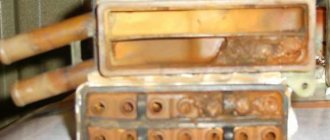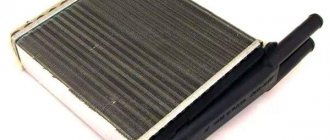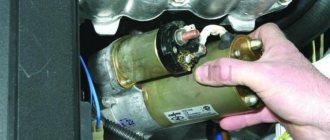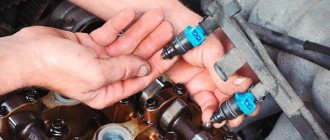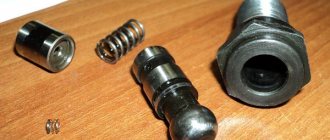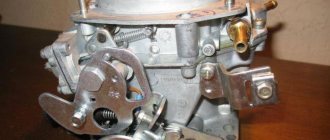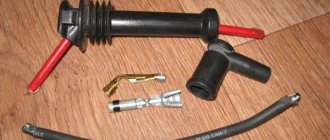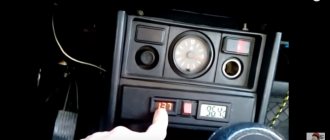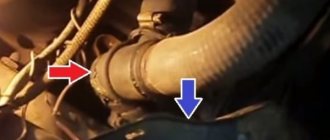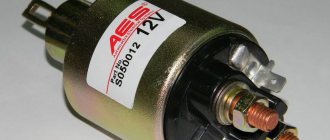The legend of the Soviet automobile industry VAZ-2107 replaced previous models. Serial production of this line lasted from 1982 to 2012. Due to the rebranding, the model is known as LADA 2107. The latest version of the Lada at the time of launch into mass production was considered the fastest in the category of rear-wheel drive sedans.
Over the entire production period, the “seventh” model of the Volzhsky Automobile Plant has undergone a lot of modernizations. The first models were produced with carburetor engines. The engine was derived from the VAZ 2106 model. In this segment, 4 variations of engine volume were produced: from 1.2 to 1.6 liters. The most popular model of the “Seven” is powered by a 1.5 liter engine.
How does a fuel injection system work?
The essence of the whole process is that gasoline is supplied under pressure into the fuel rail, in which it is mixed with purified air in a ratio of 14 to 1. The mixture is always under pressure, so when the valve opens, it enters the combustion chamber unhindered. Here ignition occurs and the piston makes a power stroke. At the same time, the crankshaft rotates and the car is set in motion.
A bunch of sensors are responsible for the normal operation of all components, which measure temperature, pressure, amount of air and gasoline, etc. All signals are sent to a microcontroller control unit. It contains a special algorithm that regulates the operation of all main components and mechanisms. This is what we will talk about the VAZ-2107 engine (injector) in our article. Or more precisely, about its components.
Possibilities for re-equipping a VAZ 2107 car
To improve the capabilities of their car, drivers often use tuning of the VAZ 2107 engine, replacing the standard power unit with a motor that has more power. To carry out this activity, it is necessary to consult with qualified specialists. When re-equipping a car, you need to consider the following possibilities:
- Is the newly selected motor suitable for the “seven” in size and weight?
- Is it possible to mate the new engine with the transmission of the car?
- Is this motor compatible with each of the systems of this car?
Practice shows that in terms of compatibility with the VAZ 2107, power units from Fiat or Nissan are closest. Installation of such motors requires minimal subsequent modifications.
Crankshaft sensor
This is one of the important reading devices, available on any injection engine, including “sevens”. With its help, the number of revolutions of the crankshaft is read. If you take a closer look at the design of the entire assembly, you can see that the sensor is installed opposite the teeth of the crankshaft pulley. And you can see that the distance between the teeth is the same, but not everywhere. There is a gap in which two teeth are missing - it is this segment that is the “setter”. The sensor catches it and begins to count a new revolution of the pulley.
Using this device, the number of revolutions is recorded. Based on the data received from the sensor, the electronic control unit decides whether to increase or decrease the amount of air or gasoline in the mixture. But that’s not all, other devices also affect the work, which we will talk about later.
Overhaul of VAZ engine
Most car enthusiasts carry out VAZ engine repairs with their own hands. The simple design and arrangement of components makes it easy to troubleshoot. But the overhaul of a VAZ engine will require special equipment, such as boring and honing machines.
The engine overhaul is often done with your own hands, but the cylinder block and crankshaft are taken to a specialized car service center for boring. The crankshaft repair sizes are 0.25, 0.5, 0.75 and 1.0. As for the block, the repair size step is 0.5 mm.
The most common question that motorists ask is: on which VAZ engines does the valve bend? The valves can bend on any engine where the timing drive mechanism breaks.
Air flow sensor
This is a device that allows you to record the amount of air that enters the fuel rail. The design is based on a platinum thread, which in some cases becomes dirty. To extend the life of this device, it is necessary to change the air filter in a timely manner. If the degree of contamination is small, it is possible to clean the thread using an injector cleaner.
The essence of the work is that the thread is heated to a certain temperature. When air passes through the tube, the thread cools by several degrees. The logic installed in the control unit calculates the amount of air that enters the ramp. This is the easiest way to count the air entering the ramp to form the mixture.
Major renovation
As an alternative replacement option, you can consider major repairs or tuning.
Repairing your original engine will allow you to save a lot of money. And as a result, you will receive a unit that will be in no way inferior to the new engine you purchased. If it is necessary to increase power, it is enough to install larger cylinders and bore the block. You can also increase the compression and install a turbine. Such tuning will make your car a real “beast”. To extend the life of the power plant, you need to install high-quality parts and use good quality oil. The easiest way to increase power is to bore the power plant by 3 mm for an 82 mm piston. To get a more torquey engine and to further increase the volume to 1.8 liters, you will have to increase the piston stroke to 84 mm.
One of the advantages of repair and tuning is that there is no need to re-register the car. You can spend the saved money, for example, on improving the braking system, increasing comfort, etc. You don’t have to do all this yourself. Even if you use the services of a car service, it will cost less than buying and installing a new engine.
Ignition system
Carburetor engines had mechanical ignition distributors (both contactless and contact). But they all have one big drawback - friction is still present to a greater or lesser extent, so the reliability of the entire mechanism is low.
As for injection engines, all parameters are read using sensors. The signals are sent to the electronic control unit and then processed. The logic allows you to adjust the ignition timing and the timing of fuel injection into the combustion chamber. Spark plugs and armored wires are used exactly the same as on carburetor engines.
It is worth noting that modern cars are equipped with an ignition system in which a separate coil is installed on each spark plug and a low-voltage wire is connected to it. In this simple way we managed to avoid the presence of high voltage under the hood.
Removing and washing VAZ-2107 injectors
In this article I will describe the process of removing injectors on a VAZ-2107 car. The owner complained about tripping and rough operation of the engine when running on gasoline. After diagnostics, it was discovered that the injectors were clogged. The car is additionally equipped with 2nd generation gas equipment, the so-called “cracker”. In this regard, the view in the photographs may differ slightly from yours (presence of a firecracker, injector emulator, etc.). In Fig. Figure 1 shows the appearance of the engine compartment of the vehicle being serviced.
Let's get started. We unscrew the fastening clamps (Fig. 2) of the air pipe using a Phillips screwdriver or a 7 mm “head”.
Remove the pipe (Fig. 3).
Remove the throttle cable clamp using a “flat” screwdriver, carefully prying it off (Fig. 4).
Opening the throttle valve, remove the throttle cable (Fig. 5, 6).
We unscrew the fastening of the throttle cable using a 10 mm “head” (Fig. 7).
We unscrew the fuel lines with two 17 mm open-end wrenches. We unscrew the fastening of the tubes with a Phillips screwdriver (Fig. 8).
Remove the vacuum hose from the fuel pressure regulator (Fig. 9, 10).
Remove the vacuum brake booster hose by unscrewing the clamp with a “flat” screwdriver (Fig. 11).
We unscrew the two nuts securing the throttle assembly using a 13 mm “head” (Fig. 12, 13). We remove it, holding the washers on the studs, and move it to the side.
We unscrew the nuts securing the intake manifold using a 13 mm “head” (Fig. 14). We remove the washers.
Damper position sensor
The throttle valve is a unit that allows you to change the amount of air supplied to the fuel rail. Essentially, when you press the accelerator pedal, you are increasing the amount of air, not gasoline. Based on how much oxygen enters the ramp, the volume of gasoline will increase or decrease. In total, you can find two types of sensor designs:
The former are similar in principle to volume controls in household appliances. They have one big drawback - they have rubbing surfaces, so the device often fails. The development is usually present at the very beginning of the track. If the position sensor breaks down, there will be a frequent change in idle on the VAZ-2107 (the injector cannot understand what position the pedal is in, since the resistance of the sensor is unstable).
The contactless sensor does not have such disadvantages (it works on the encoder principle). But its cost is much higher, so ordinary drivers rarely install them on their cars.
Speedometer repair
Today, a car is probably the most comfortable way to travel. A car has many advantages over public transport, but each of these advantages is in one way or another associated with the cost of money and your time. Naturally, one way or another, you will have to set aside time to care for your vehicle, because you cannot do without breakdowns. A fairly common problem with the instrument panel is a malfunction of the speedometer. Naturally, experienced motorists can quite easily determine the speed of a car by eye, but inexperienced drivers will not be able to do this. To avoid dangerous situations on the roads, every driver must be able to repair the dashboard.
So, to repair the speed sensor on a VAZ 21074 car you will need:
- Set of tools;
- Instructions for using the vehicle;
- Sealant;
- Plastic fork.
Instrument panel VAZ 21074
Naturally, not every owner of a VAZ 21074 car has instructions for using the vehicle, but if you have one, then first study it, and only then start repairing the speedometer. The instructions for using the car contain a huge number of useful tips that it is advisable to take into account when traveling by car. Probably, many people now have a question, how to determine a malfunction of the speed sensor, which measures the maximum speed of the car. So, here are a few main signs of a malfunctioning speedometer:
- The speedometer needle moves regularly.
- When the arrows are in one location, they stop moving altogether.
After diagnosing a malfunction of the speedometer, the following actions must be taken:
The teeth on the gears of the speed sensor, which are located on the back of the instrument panel, are worn out or worn out. The speed sensor cable has broken. In this case, it is necessary to completely replace the sensor. The shape of the arrow that measures the speed of the car has changed
In this case, it is necessary to replace the arrow, and to do this you need to carefully pry off the damaged part using a plastic fork and install a new arrow.
Having diagnosed the cause of the speedometer malfunction, replace the broken part, but if you were unable to find the cause of the breakdown, then simply try to correct the arrow, maybe it’s just stuck
After carrying out repair work, carefully reassemble everything in the reverse order, because inattentive assembly can affect the functioning of the vehicle
Removing the instrument panel
In some cases, minor repairs will require removing the instrument panel. This need may arise when replacing backlight bulbs.
So, the algorithm for removing the dashboard:
- Disconnect the negative battery cable;
- Remove the handle of each heater control lever using a slotted screwdriver;
- Unscrew the nut that secures the reset handle for the car's daily mileage sensor;
- Push the handle behind the dashboard;
- Using a thin screwdriver, pry up and remove the screw plug that secures the dashboard. The plug is located on the right side of the control lever block for the heating and ventilation system of the vehicle interior.
- Unscrew the screw securing the dashboard;
- Pull out the instrument panel of the VAZ 21074;
- Unscrew the knurled nut of the speed sensor drive cable and disconnect the cable;
- Remove the hose from the economizer fitting;
- Remove the colored pads from each wiring harness;
- Remove the instrument panel completely.
https://youtube.com/watch?v=1mFdhZTxeHM
Fuel injectors
These are one of the main components; their cleaning and replacement on the VAZ-2107 (injector) must be done in a timely manner. Filters also affect the life of injectors. Essentially, injectors are solenoid valves that stand in the way of the movement of the fuel mixture. The electronic control unit gives the command to open and close them, based on sensor readings.
To protect electrical circuits, fuses are installed in the mounting block. On the VAZ-2107 (injector), all components are protected, and the injectors must be turned on via an electromagnetic relay, since they have a high current consumption.
Transmission
| Clutch | single-disk, dry, with hydraulic shutdown drive and central diaphragm spring | |||
| Transmission | mechanical, four- or five-speed, three-way, three-shaft, with synchronizers on all forward gears | |||
| Gear ratios: | ||||
| first | 3,67 | |||
| second | 2,10 | |||
| third | 1,36 | |||
| fourth | 1,0 | |||
| fifth | 0,82 | |||
| reverse | 3,53 | |||
| Cardan transmission | two-shaft, with intermediate support and elastic coupling | |||
| main gear | hypoid | |||
| Final drive ratio | gear ratio - 3.9 or 4.1 | |||
| Differential | conical, two-satellite | |||
“Seven” is the latest representative of the VAZ series of rear-wheel drive cars. The seventh model was developed on the basis of the VAZ 2105 and differs in the shape of the seats, interior trim, shape of lighting devices and engine power.
Initially, the VAZ 2107 was equipped with a one and a half liter engine from the VAZ 2103. Subsequently, the range of engines installed on the “seven” was expanded. Cars with engine sizes ranging from 1.45 to 1.7 liters were produced for different markets. It was the 1.7 liter engine that was the first to be equipped not with a carburetor, but with an injection power system. Subsequently, the VAZ 2107 injector completely removed carburetor cars from the assembly line.
Fuel pressure sensor
This device is necessary to prevent high pressure from building up in the fuel rail. A pump located in the tank pumps gasoline through pipelines into the fuel rail to a certain pressure. It should be enough for the mixture to be injected into the combustion chamber. The sensor is installed directly on the ramp, and if the maximum permissible pressure value is exceeded, the excess is released through a check valve into the line connected to the tank. The operating principle is approximately the same as that of the expansion tank cap in the cooling system.
Causes of clogging of the distributed injection system
One of the faults, a clogged injector, can be repaired with your own hands. The cause of the blockage is the use of low-quality gasoline. The lower the quality of the fuel, the more heavy paraffins it contains. They are deposited on the walls of the fuel system, clog the injector openings, making it difficult to supply fuel.
In addition, paraffins are deposited on the exhaust valves, which leads to their burnout. The engine begins to detonate.
To prevent this from happening, you need to use high-quality gasoline with special additives. But if clogging cannot be avoided, you can wash it yourself using a special flush of injection systems.
To rinse, you must have a syringe and rinsing liquid.
Mix the liquid with gasoline in the proportion indicated in the instructions on the bottle. We fill it into the fuel distribution system through the hose fitting of the vacuum brake booster. First we do this with the engine not running. Then we start it and add the mixture in small portions. This helps break down paraffin deposits. Under the influence of washing, paraffin deposits dissolve, enter the cylinder, burn and come out along with the exhaust gases. In this case, black smoke may come out of the exhaust pipe.
Lambda probe
This is a sensor that allows you to estimate the oxygen content in exhaust gases. It should be noted that direct measurements cannot be taken, so you have to install a sensitive element inside and outside the exhaust pipe. And to improve sensitivity, you need to warm up the device to 600 degrees.
This sensor sets the ignition timing and regulates the quality of the fuel mixture. The presence of the device is due to the introduction of toxicity standards.
How does the fuel injection system work?
Now let's talk about how the fuel injection system works. So, from the very beginning:
- You turn the ignition key, power is supplied to the electronic control unit, all sensors and actuators.
- After the crankshaft begins to rotate, the VAZ-2107 generator (injector) starts working with the starter.
- All sensors record changes in the parameters they measure.
- The electronic control unit adjusts the quality of the mixture and regulates the ignition timing.
- The mixture is fed under pressure into the combustion chambers through open nozzles, and the ignition process and working stroke begin.
Engines
| Options | VAZ 2103 | VAZ 2106 | VAZ 2104 | VAZ 21067 |
| Number and arrangement of cylinders | four-cylinder, four-stroke, in-line | |||
| Supply system | carburetor | distributed injection | ||
| Octane number of gasoline | 92-93 | 95 | ||
| Cylinder diameter and piston stroke, mm | 76×80 | 79×80 | 76×80 | 79×80 |
| Cylinder operating order | 1-3-4-2 | |||
| Compression ratio | 8,5 | 8,5 | 8,5 | 8,5 |
| Working volume, l | 1,45 | 1,57 | 1,45 | 1,57 |
| Rated power, according to GOST 14846 (net), kW (hp) | 52,5 (71,4) | 54,8 (74,5) | 50,0 (68,0) | 54,5 |
| Crankshaft rotation speed at rated power, min -1 | 5600 | 5600 | 5000 | 5000 |
| Maximum torque at crankshaft speed 3400 min -1 (3000 min -1 for VAZ 2106 engine), N*m | 103,9 | 116 | — | — |
| Minimum crankshaft rotation speed, min -1 | 850-900 | 850-900 | 820-880 | 820-880 |
| Direction of rotation of the crankshaft from the pulley side | right | |||
| Lubrication system | combined, pressure and spray | |||
| Cooling system | liquid, closed, forced circulation | |||
| Crankcase ventilation system | forced, with crankcase gases vented into the intake manifold | |||
What engines was equipped with the VAZ 2107
"Seven" was produced for a very long time - from 1972 to 2012. Of course, during this period, the vehicle’s configurations and equipment changed and were modernized. But initially (in the 1970s) the VAZ 2107 was equipped with only two types of engines:
- From its predecessor 2103 - a 1.5 liter engine.
- From 2106 - 1.6 liter engine.
On some models, more compact 1.2 and 1.3 liters were also installed, but such cars were not widely sold, so we will not talk about them. The most traditional for the VAZ 2107 is a 1.5 liter carburetor engine. Only later models began to be equipped with 1.5 and 1.7 liter injection engines.
Moreover, a number of rear-wheel drive VAZ 2107 exhibits were equipped with front-wheel drive engines, but the designers immediately abandoned such an idea - it was too labor-intensive and unjustified.
VAZ 2107: description, engines, automatic transmission, technical characteristics
VAZ 2107 is a Russian car of the 3rd group of small class in a sedan body, produced from 1982 to 2014 by the Volzhsky Automobile Plant. The model was assembled in the USSR, Russia, Ukraine and Egypt. In fact, the car is a modified luxury version of the VAZ-2105 model. According to the Autostat agency, at the beginning of 2021, about 1.75 million people drove the “Seven” in Russia. 2107 is widely used in sports in both Russian and European auto racing.
Engine VAZ 2103 1.5
The VAZ 2103 engine with a displacement of 1.5 liters represents the third of four generations of Tolyatti classics. He was the heir to the 2101 1.2 liter and 21011 1.3 liter engines. And the 2103 engine itself became the basis for the creation of the 1.6 liter 2106 engine. This is where the classic line of engines ended, giving way to fuel injection and front-wheel drive. Read more about VAZ 2103 1.5 engine...
Engine VAZ 2106 1.6
The VAZ 2106 1.6 engine is a four-stroke, carburetor, in-line, with an overhead camshaft. The engine cooling system is liquid, closed type, with forced circulation of liquid. The engine has a combined lubrication system: pressure and splash. Read more about VAZ 2106 1.6 engine...
Engine VAZ 2105
The VAZ 2105 engine appeared in 1979 and, with minor changes, was able to last on the assembly line until 2006. Initially, this power unit had a carburetor power system, but later received a reliable injector, which made it possible to significantly increase engine power. A modified engine from the VAZ 21011 was installed on the new VAZ 2105. The main difference between the new engine and the VAZ 21011 is the presence of a belt drive, which made it possible to reduce the noise levels of the engines. Read more about the VAZ 2105 engine...
Source
Technical characteristics of the “Seven” injection engine
In carburetor systems, the creation of a combustible mixture is carried out directly in the chambers of the carburetor itself. However, the essence of the operation of the injection engine on the VAZ 2107 comes down to a different approach to forming the fuel-air mixture. The injector sharply injects the fuel itself into the working cylinders of the engine. Therefore, such a system for creating and supplying fuel is also called a “distributed injection system.”
The injection model VAZ 2107 is equipped from the factory with a separate injection system with four injectors (one injector for each cylinder). The operation of the injectors is controlled by the ECU, which regulates the flow of fuel to the cylinders, obeying the requirements of the microcontroller.
The injection engine on the VAZ 2107 weighs 121 kilograms and has the following dimensions:
- height - 665 mm;
- length - 565 mm;
- width - 541 mm.
Injector ignition systems are considered more convenient and modern. For example, the VAZ 2107i has a number of important advantages over carburetor models:
- High engine efficiency thanks to precise calculation of the amount of fuel injected.
- Reduced fuel consumption.
- Increased engine power.
- Stability of idling, as all driving modes are controlled via the on-board computer.
- No need for constant adjustment.
- Environmentally friendly emissions.
- Quieter engine operation thanks to the use of hydraulic compensators and hydraulic tensioners.
- You can easily install cost-effective gas equipment on the “Seven” injection models.
However, injection models also have disadvantages:
- Difficult access to a number of mechanisms under the hood.
- High risk of catalytic converter damage on rough roads.
- Capriciousness regarding fuel consumed.
- The need to contact a car repair shop for any engine malfunctions.
Table: all 2107i engine characteristics
| Year of production of engines of this type | 1972 - our time |
| Supply system | Injector/carburetor |
| engine's type | Row |
| Number of pistons | 4 |
| Cylinder block material | cast iron |
| Cylinder head material | aluminum |
| Number of valves per cylinder | 2 |
| Piston stroke | 80 mm |
| Cylinder diameter | 76 mm |
| Engine capacity | 1452 cm 3 |
| Power | 71 l. With. at 5600 rpm. |
| Maximum torque | 104 Nm at 3600 rpm. |
| Compression ratio | 8.5 units |
| Oil volume in crankcase | 3.74 l |
Description of the advantages and disadvantages of VAZ 2107 injectors
The design of an injection-type engine gives every reason to talk about undeniable advantages in comparison with carburetor engines:
- The efficiency is much higher, and fuel consumption is correspondingly reduced.
- The engine power has higher performance with volumes similar to carburetor engines.
- Engine stability at idle speed.
- Guaranteed cold start.
- There is no need to adjust the ignition system and gasoline supply.
- The optimal composition of the air-fuel mixture helps reduce the amount of harmful elements in the exhaust gases.
- No noise effects when the engine is running due to the presence of a hydraulic chain tensioner and a hydraulic compensator that regulates valve clearances.
- Achieving high torque at different speeds.
Injection engines can also run on gas. The most preferred is the fourth generation of gas equipment.
The most common shortcomings include the following:
- The injection engine, located in the former inconvenient engine compartment, has difficult access to working units and parts.
- Increased requirements for the quality of gasoline; when using low-quality fuel, accelerated contamination of the fuel system is observed, requiring unscheduled maintenance activities.
- If the injection system fails, it is necessary to contact the services of specialists so that they carry out the necessary maintenance, adjustments, and restoration of engine operation.
It has become not so easy to independently find a breakdown and repair the VAZ 2107 injection engine with your own hands. The engine overhaul is also carried out in auto repair shops equipped with specialized equipment.
In a garage, you can perform such an operation as an urgent or scheduled oil change in a VAZ 2107 engine.
Where is the engine number
The engine number is unique to each vehicle. This is a kind of model identification code. On injection-powered "sevens" this code is stamped out and can be located only in two places under the hood (depending on the year of manufacture of the car):
- on the bottom shelf of the air supply box on the right;
- on the cylinder block.
All designations within the engine number must be clearly readable and not cause double interpretation.
On-board computer for VAZ 2107 injector
The state, by the way, is not the only BC model that can be installed on a car with a 21074 engine, but we will still start with it, as with it officially developed under the wing of the automobile plant. Officially, the factory declares the device as intended for installation instead of a button plug. Well, it’s a good alternative, let’s see what it can do besides its main declared function. Slots in casinos are gaining more and more popularity because with their help it is possible to win and hit the jackpot. Top online casinos in Russia provide reviews of gaming clubs for fans of gambling and slots, helping to find the best casinos. We’ll tell you where and how you can play for rubles in Russian casinos, as well as where to find current promotional codes and generous casino bonuses for today.
Video tutorial on installing an on-board computer in a VAZ 2107
The device is fully compatible with January controllers versions from 5.1 to January 7.2, as well as Itelma, Avtelm 73 under Euro3, but is not intended to work with Bosch controllers, which are installed on nines. Therefore, the State 2107×1 works only with an injection seven engine. The device is quite easy to understand. It only has two buttons and three numbers. As a plug, you can't think of a better one. But besides this, the device has as many as 30 functions. It makes sense to dwell on some of the most useful ones in more detail.
What kind of engine can be installed on the “seven” instead of the standard one?
The driver begins to think about changing the engine when, for some reason, he is no longer satisfied with the operation of the standard equipment. In general, the 2107 model is excellent for various kinds of technical experiments and tuning, but the rational approach to choosing new equipment has not yet been canceled.
Therefore, before you even think about a new motor for your swallow, you need to weigh the pros and cons, namely:
- what goals need to be achieved when replacing a standard engine;
- are there technical capabilities to safely connect the motor;
- Is it possible to do the replacement yourself, etc.
Engines from other VAZ models
Naturally, engines from cars of the same family can be installed on the VAZ 2107i without significant modifications and loss of time. Experienced car enthusiasts advise taking a closer look at engines from:
These are more modern power units with an increased number of “horses”. In addition, the engine dimensions and connection connectors are almost identical to the standard equipment of the “Seven”.
Engines from foreign cars
Imported engines are rightfully considered more reliable and durable, so the idea of installing a foreign-made engine in a VAZ 2107i often excites the minds of drivers. It must be said that this idea is quite feasible if we take Nissan and Fiat models from 1975–1990 as donors.
The thing is that Fiat became the prototype of the domestic Zhiguli, so structurally they have a lot in common. And Nissan is also technically similar to Fiat. Therefore, without significant modifications, you can install engines from these foreign cars on the VAZ 2107.
Rotary power units
On "sevens" rotary engines are not that uncommon. In fact, due to the specifics of their work, rotor mechanisms can significantly optimize the operation of the VAZ 2107i and give the car acceleration and power.
An economical rotary engine ideal for the 2107 is a modification of the RPD 413i. The 1.3-liter unit develops power up to 245 horsepower. The only thing the driver should know about in advance is the drawback of the RPD 413i - a service life of 75 thousand kilometers.
Today, the VAZ 2107i is no longer produced. At one time it was a good car at an affordable cost for living and working. The injection modification of the “Seven” is considered to be maximally adapted to Russian operating conditions; moreover, the car is easily amenable to various kinds of under-hood upgrades and alterations.
Source
Engine VAZ 2106
The design of the VAZ 2106 engine is almost completely identical to the VAZ 2103 engine, with the exception of some nuances, such as engine displacement.
Characteristics
Dimensions and Weight are identical (see paragraph Characteristics of the VAZ 2103 engine).
Features of operation
Completely identical to the VAZ 2103 engine (see similar VAZ 2103 engine design). The oil volume in the crankcase is also the same and is 3.75 liters.
Engine tuning
Also identical to the VAZ 2103 engine. See the section Engine tuning (VAZ 2103). The features of boring will be described below.
Increase in working volume
Identical to the point “Increasing the displacement of the VAZ 2103 engine” with the exception that this engine does not require sharpening the cylinder block. It has already been bored to the required values.
This concludes the article. We hope that you were interested and found answers to the questions: “What engine can be installed in my car?”, “How to increase engine power without losing reliability?” and “What is an injector?” As you can see, despite its modest engine performance, the VAZ 2107 has the potential for modernization and in terms of speed characteristics it can be on par with modern cars.
